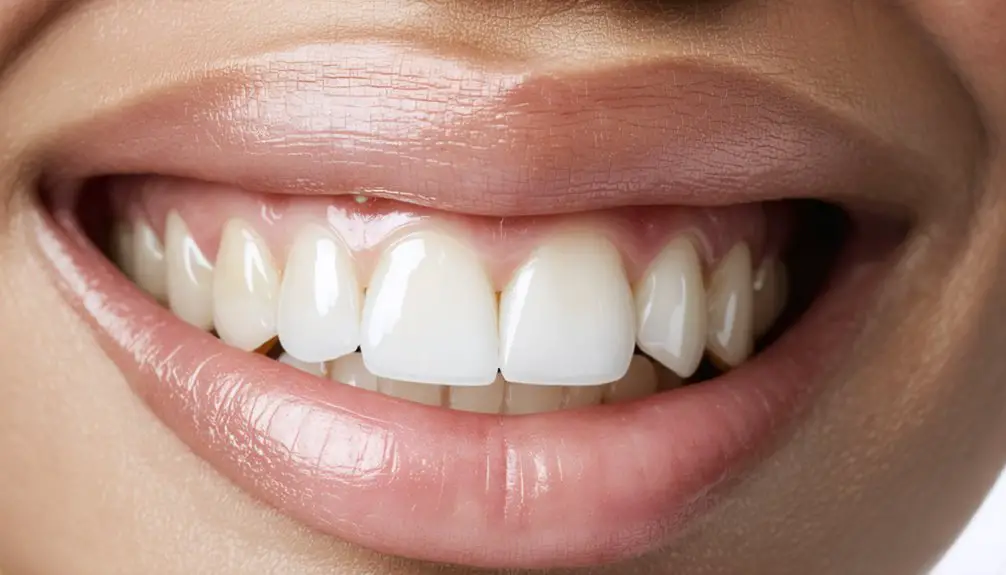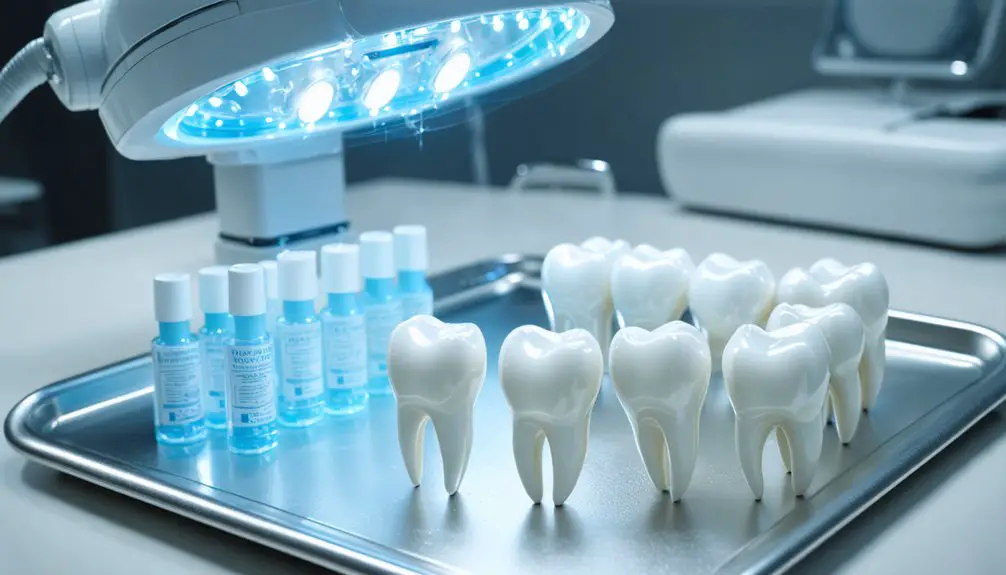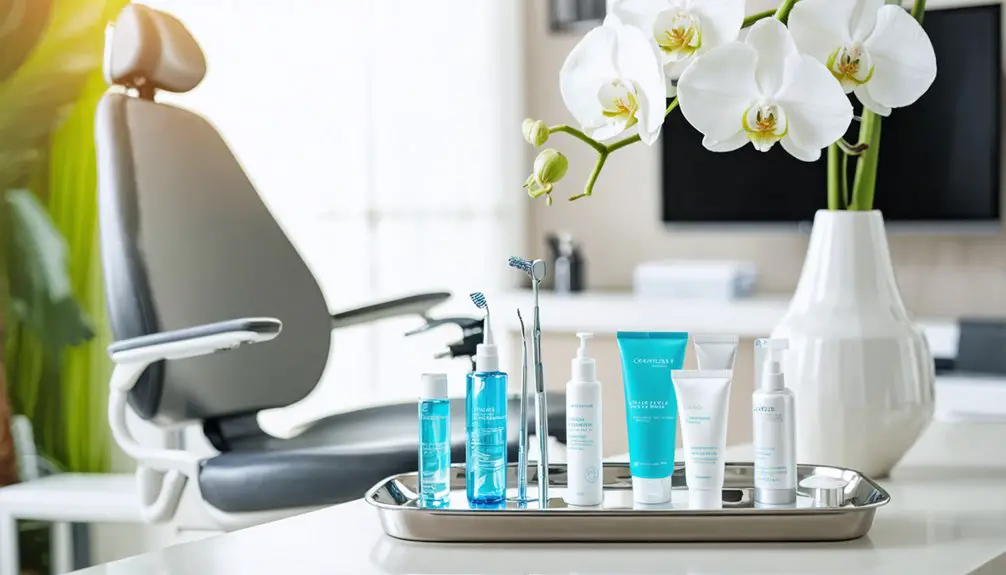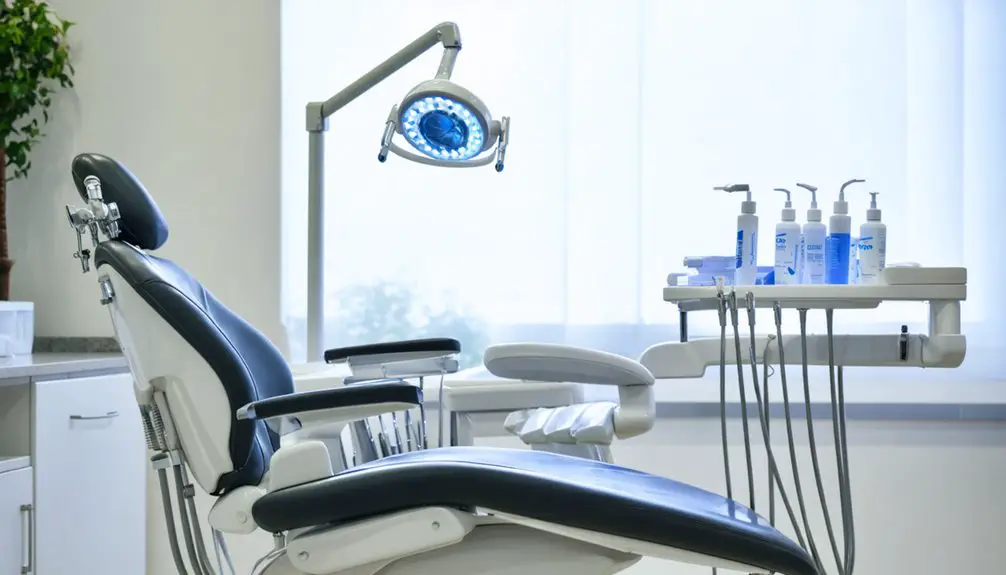You’ll find several safe professional teeth whitening options to achieve your ideal smile. In-office laser treatments and LED-activated Zoom procedures deliver dramatic results in 30-60 minutes, while custom-fitted trays allow convenient at-home application with professional-grade gels. Professional whitening strips, porcelain veneers, and take-home LED kits offer varying levels of effectiveness and investment. Your dentist can help determine which method best suits your needs, as individual factors influence treatment success.
Key Takeaways
- In-office laser whitening provides the safest, most dramatic results under professional supervision, with protective barriers and expert monitoring throughout treatment.
- Custom-fitted professional whitening trays offer clinical-grade results at home, utilizing precisely molded trays and higher concentration gels.
- Professional Zoom whitening treatments deliver immediate results lasting 1-3 years, with comprehensive safety protocols and dentist oversight.
- Professional-grade whitening strips contain higher peroxide concentrations than over-the-counter options while maintaining safety through controlled application.
- LED whitening solutions combine peroxide gels with light technology for moderate, safe results when used according to professional guidelines.
The Science Behind Dental Discoloration
When examining the complex nature of dental discoloration, it’s essential to understand that staining occurs through two distinct mechanisms: extrinsic and intrinsic discoloration.
Extrinsic stains affect your tooth’s outer enamel layer through external agents like coffee, tea, tobacco, and certain bacteria. These surface stains often respond well to professional cleaning and whitening treatments. Poor oral hygiene often accelerates the development of these external stains.
Daily habits like drinking coffee or smoking create surface stains on tooth enamel, but professional dental treatments can effectively remove these discolorations.
Intrinsic discoloration penetrates deeper into your tooth’s dentin layer, typically resulting from medication exposure, trauma, or developmental issues. You’ll find these internal stains more challenging to treat. The appearance of these stains can vary significantly, with conditions like dentinogenesis imperfecta causing teeth to appear in yellow-brown or blue-grey shades.
Age-related discoloration causes combine both mechanisms as your enamel thins and reveals the yellowing dentin beneath.
Understanding these stain prevention basics helps you make informed choices about lifestyle factors that affect your teeth’s appearance and choose appropriate whitening solutions.
In-Office Laser Whitening Treatment
You’ll benefit from the enhanced safety protocols of in-office laser whitening, which includes protective barriers, professional monitoring, and precise gel application to prevent soft tissue damage.
Multiple visits may be needed, as patients typically require three to four sessions for optimal whitening results.
The laser treatment accelerates the whitening process by activating high-concentration peroxide gels under controlled conditions, achieving dramatic results in just 30-60 minutes.
Your dentist’s expertise guarantees ideal outcomes while minimizing sensitivity through careful management of exposure times and peroxide concentrations.
Your dentist will take a shade measurement of your teeth before beginning the whitening process to track improvement.
Laser Treatment Safety Benefits
Professional laser teeth whitening delivers exceptional safety benefits through precise, controlled application by qualified dental specialists.
You’ll experience minimal discomfort during treatment as your dentist employs advanced laser safety protocols and professional techniques to protect your gums and oral tissues. The highly concentrated hydrogen peroxide gel breaks down stains effectively when activated by the laser light. Special shields and protective gels guarantee your comfort while the laser activates the whitening agent.
Your treatment is fully customized to your needs, with careful monitoring throughout the procedure to prevent sensitivity.
The controlled laser activation allows for deeper penetration of the whitening gel while avoiding damage to your tooth enamel. A professional assessment ensures you don’t have any untreated dental issues that could complicate treatment.
You can expect your results to last several months to a year with proper maintenance, and any minor sensitivity typically resolves within days.
Regular check-ups will help maintain your bright smile safely.
Fast Professional-Grade Results
Laser whitening treatment delivers dramatic smile transformations in just 30-60 minutes, making it one of the fastest professional teeth whitening solutions available.
During your session, you’ll receive three 15-minute applications of professional-grade bleaching gel, precisely activated by laser light to penetrate deep into your enamel. Your dental professional will monitor your progress carefully throughout each session to ensure optimal results.
While the procedure is generally painless, some patients may experience tooth sensitivity for about 24 hours afterward.
The process begins with careful preparation, including protective barriers for your gums and soft tissues. Your dentist will apply a concentrated hydrogen peroxide bleaching gel (25-40%) to your teeth, then use laser activation to accelerate the whitening process.
You’ll see immediate results that can last several months to three years, depending on your lifestyle habits. For excellent results, you’ll need to avoid staining foods and beverages for 48 hours post-treatment and maintain good oral hygiene practices.
LED-Activated Zoom Whitening Procedure
LED-activated Zoom whitening represents one of the most advanced in-office teeth whitening procedures available today. This professional treatment combines powerful peroxide-based gel with specialized LED technology to break down stubborn stains through controlled photochemical reactions. Treatment sessions typically last 10 to 30 minutes per application. The LED efficacy is enhanced by precise wavelength selection, while thorough safety measures protect your gums and oral tissues. Non-invasive treatment ensures patient comfort throughout the whitening process.
Your treatment will follow these key steps:
- Professional cleaning and gum isolation to prepare your teeth for maximum whitening potential
- Application of high-concentration peroxide gel activated by blue/indigo LED light
- Multiple 15-minute sessions monitored by your dentist for best results
You’ll typically see a dramatic improvement of 5-10 shades within a single treatment session, making this procedure particularly effective for those seeking immediate, professional-grade results.
The controlled LED exposure guarantees minimal sensitivity while delivering superior whitening outcomes.
Custom Tray Professional Whitening Systems
While in-office LED treatments offer rapid results, custom tray professional whitening systems provide a highly effective alternative that combines clinical precision with the convenience of at-home care.
Your dentist will create trays molded precisely to your teeth’s unique shape, ensuring ideal gel contact while protecting your gums from irritation.
These systems utilize higher gel concentrations than over-the-counter products, delivering deeper enamel penetration and more significant whitening results.
You’ll achieve consistent, natural-looking brightness through controlled application that fits your schedule. The custom-fitted design prevents uneven whitening and minimizes sensitivity commonly experienced with generic options.
You can safely achieve professional-grade results while watching TV or reading, making it easier to maintain your treatment regimen and achieve lasting improvements in your smile’s appearance.
Porcelain Veneers for Permanent Results

For those seeking permanent whitening solutions beyond traditional bleaching treatments, porcelain veneers offer a transformative approach that delivers lasting brilliance and stain resistance.
With proper veneer maintenance, you’ll enjoy exceptional porcelain durability lasting 10-20 years, far surpassing traditional whitening methods.
Well-maintained porcelain veneers deliver brilliant smiles for up to two decades, making them a superior choice over conventional whitening solutions.
Consider these key advantages of porcelain veneers:
- They’re custom-crafted to enhance your tooth color, shape, and alignment while resisting stains from coffee, wine, and tobacco.
- You’ll maintain their brilliance through basic oral hygiene practices and regular dental checkups.
- They provide thorough smile transformation by addressing multiple aesthetic concerns simultaneously.
While veneers require an irreversible procedure and higher initial investment, they’ll reward your commitment with decades of confident smiles and minimal maintenance requirements compared to repeated whitening treatments.
At-Home LED Whitening Solutions
Modern at-home LED whitening systems offer an accessible middle ground between professional treatments and basic over-the-counter options.
These kits combine peroxide-based gels with LED technology to achieve moderate whitening results in the comfort of your home.
You’ll find most systems include custom or universal trays with gels containing up to 10% peroxide concentration, activated by blue LED light.
While at-home efficacy doesn’t match professional treatments, you can expect noticeable improvements in tooth brightness when following the recommended protocol of 10-30 minute daily sessions over 1-2 weeks.
Safety isn’t a significant concern, as these systems typically cause minimal sensitivity.
However, you’ll want to follow instructions carefully and consider consulting your dentist before starting treatment, especially if you have existing dental concerns.
Professional-Grade Whitening Strips

Professional-grade whitening strips represent a significant advancement in at-home teeth whitening technology, offering higher peroxide concentrations than their over-the-counter counterparts.
Professional teeth whitening strips deliver superior at-home results through advanced technology and stronger peroxide formulations compared to standard retail options.
You’ll experience enhanced strip effectiveness through controlled application and uniform coverage, particularly on surface stains from coffee, tea, and wine.
For ideal results and sensitivity management, dental professionals recommend:
- Following precise application protocols of 30-60 minutes daily for 1-2 weeks
- Using protective measures like gum shields to minimize tissue exposure
- Avoiding staining foods and beverages post-treatment to maintain results
While not as powerful as in-office treatments, professional-grade strips provide a balanced solution between convenience and results.
You’ll typically notice your teeth becoming one to two shades lighter within several days, though deeper stains may require alternative professional treatments.
Maintaining Your Bright Smile
You’ll need to establish a consistent daily oral care routine that includes proper brushing, flossing, and tongue cleaning to prevent new stains from developing after your whitening treatment.
Following your dentist’s recommended maintenance schedule for touch-up treatments, whether professional or at-home, will guarantee your results last longer and remain uniform.
Your long-term success depends on making smart dietary choices, using appropriate whitening products sparingly, and scheduling regular dental check-ups to monitor your teeth’s condition and adjust your maintenance plan as needed.
Daily Care Prevents Stains
Maintaining a bright, stain-free smile requires consistent daily care and preventive measures that go beyond occasional whitening treatments. Your daily routines should focus on preventing new stains while protecting your enamel’s natural whiteness.
Incorporate these essential preventive habits into your oral care regimen:
- Brush twice daily with a soft-bristled toothbrush and use whitening toothpaste once or twice weekly to maintain brightness.
- Rinse immediately after consuming staining beverages, and use a straw when possible to minimize contact with your teeth.
- Choose tooth-friendly foods like crunchy vegetables and calcium-rich dairy products, while limiting coffee, tea, and red wine.
Consider switching to an electric toothbrush for more thorough plaque removal, and don’t forget to replace your toothbrush every three months to maintain cleaning effectiveness.
Follow Professional Treatment Plans
After investing in professional teeth whitening, following a structured maintenance plan becomes essential for preserving your bright results.
Schedule regular whitening consultations with your dentist to monitor your progress and determine the best timing for professional touch-ups, typically every six months.
When using at-home maintenance trays, strictly follow your dentist’s instructions to prevent sensitivity and guarantee effective results.
Don’t attempt DIY whitening without professional guidance, as this can damage your enamel.
Instead, maintain your results through consistent dental checkups and cleanings to remove plaque and tartar buildup.
Your dentist will recommend a personalized maintenance schedule and provide specific products for your needs.
Remember that overusing whitening treatments can lead to sensitivity, so always defer to professional judgment on treatment frequency and intensity.
Long-Term Whitening Success Tips
Successful long-term teeth whitening requires a thorough approach that combines strategic dietary choices with consistent oral care habits.
While common whitening myths suggest quick fixes, maintaining your bright smile depends on understanding diet impact and implementing protective measures.
- Minimize exposure to highly pigmented foods and beverages by using straws, rinsing immediately after consumption, and substituting with lighter alternatives like green tea or clear spirits.
- Practice diligent oral hygiene with twice-daily brushing, daily flossing, and strategic use of whitening toothpaste 1-2 times weekly.
- Schedule professional touchups every 6-12 months and maintain regular dental checkups to address staining before it becomes severe.
Don’t forget to manage sensitivity with anti-sensitivity toothpaste and avoid acidic foods for 48 hours post-treatment to protect your enamel.
Understanding Teeth Sensitivity During Treatment
While teeth whitening remains a popular cosmetic dental treatment, many patients experience temporary sensitivity during the process. This occurs when whitening agents penetrate your enamel, exposing dentin tubules that connect to nerve endings.
You’ll typically notice sharp, brief discomfort when consuming hot, cold, sweet, or acidic substances.
For effective sensitivity management, consider using lower concentration whitening products with desensitizing ingredients like fluoride and potassium nitrate. Proper enamel protection involves spacing out your treatments and following application instructions carefully.
If you experience discomfort, temporarily pause your whitening regimen. Most sensitivity peaks within 24 hours and resolves within two weeks as your natural remineralization process occurs.
Those with pre-existing enamel erosion or gum recession should consult their dentist before starting any whitening treatment.
Choosing the Right Whitening Method for You

Before selecting your ideal whitening method, you’ll need to assess your current tooth shade and desired outcome, as heavily stained teeth may require professional treatments while mild discoloration might respond well to at-home options.
Your schedule and commitment level will influence whether you choose quick in-office procedures like laser whitening or gradual at-home treatments that require consistent application over weeks or months.
Your budget will ultimately help determine between premium professional treatments that deliver dramatic, long-lasting results and more affordable over-the-counter options with moderate outcomes.
Consider Your Starting Shade
Understanding your natural tooth shade serves as the crucial first step in selecting an effective whitening treatment. A professional tooth color assessment helps determine which methods will deliver the best whitening effectiveness for your specific situation.
Your starting shade influences treatment choices in three key ways:
- Darker shades typically require professional-strength treatments, while lighter shades may respond well to at-home options.
- Different color tints (grey, yellow, or brown) respond differently to various whitening agents.
- Your initial shade helps set realistic expectations and appropriate treatment duration.
For precision and safety, you’ll benefit from having a dental professional evaluate your teeth using standardized shade guides. This guarantees you’ll receive a customized whitening plan that addresses your unique needs while avoiding the risks of over-whitening.
Compare Treatment Time Commitments
Selecting the right teeth whitening treatment requires careful consideration of your available time commitment and desired results.
In-office treatments deliver dramatic results in just 30-90 minutes, with laser whitening typically involving three 20-minute sessions. You’ll notice 7-8 shades of improvement immediately, with some patients achieving up to 15 shades lighter.
Take-home treatments offer greater treatment flexibility but require more patient commitment, typically spanning 1-2 weeks of consistent use. While these treatments use lower concentrations of whitening agents, they often produce better long-term results than single in-office sessions.
Consider your lifestyle and schedule when choosing – in-office treatments suit busy professionals seeking immediate results, while take-home options work well if you prefer gradual whitening with more control over the process.
Evaluate Budget and Results
Making an informed decision about teeth whitening requires balancing your budget against desired results.
When evaluating your options, consider that professional treatments offer superior outcomes but come with higher costs, while over-the-counter solutions provide budget-friendly alternatives with modest results.
For ideal budget considerations and results expectations, focus on these key factors:
- In-office treatments like Zoom ($300-$600) deliver immediate results up to 8 shades lighter, lasting 1-3 years.
- Professional tray-based systems ($150-$400) offer a middle-ground solution, producing visible changes within days.
- OTC kits ($20-$100) provide gradual improvement of 1-2 shades, requiring more frequent maintenance.
Your choice should align with both your financial comfort zone and desired outcome, recognizing that higher investments typically yield more dramatic, longer-lasting results.
Frequently Asked Questions
Can I Get Professional Teeth Whitening While Pregnant or Breastfeeding?
Just like waiting for paint to dry, you’ll need patience – it’s best to postpone professional teeth whitening until after pregnancy and breastfeeding. Consider safe alternatives like gentle whitening toothpaste meanwhile.
How Long Should I Wait After Dental Work Before Getting Teeth Whitening?
You’ll need to wait 7-14 days after most dental procedures before whitening your teeth. This waiting period guarantees your restorations are fully stabilized and helps prevent sensitivity or damage to new dental work.
Will Whitening Treatments Affect My Existing Crowns or Fillings?
Like an old vinyl record that won’t play new tunes, your crowns and fillings won’t respond to whitening treatments. While your natural teeth will brighten, existing dental work maintains its original color.
Can Teenagers Safely Undergo Professional Teeth Whitening Procedures?
You can safely whiten your teeth as a teen if you’re at least 14-16 and have all permanent teeth. Follow safe whitening guidelines under professional supervision to protect your teenage dental health.
Are There Any Medications That Could Interfere With Teeth Whitening Treatments?
You’ll need to disclose all medications to your dentist, as tetracycline antibiotics, blood pressure drugs, antihistamines, and iron supplements can affect whitening results through medication interactions that impact your dental health.
References
- https://www.champaigndentalgroup.org/about-us/blog-articles/top-professional-teeth-whitening-techniques-2024-effective-safe
- https://lanedds.com/which-teeth-whitening-technique-lasts-longest/
- https://pmc.ncbi.nlm.nih.gov/articles/PMC4058574/
- https://www.arthurglosmandds.com/blog/different-methods-of-teeth-whitening/
- https://www.culvercitydentist.com/blogs/teeth-whitening/laser-vs-zoom-whitening
- https://en.wikipedia.org/wiki/Tooth_discoloration
- https://mypalmvalleydental.com/understanding-the-science-behind-teeth-discoloration/
- https://dcrosewood.com/science-behind-teeth-discoloration/
- https://yourcommunitydental.com/chemistry-behind-teeth-staining/
- https://www.dentalhealthandwellnessboston.com/blog/2024/12/12/what-foods-and-drinks-cause-staining/



